
The oncilla, also known as the northern tiger cat, little spotted cat, and tigrillo, is a small spotted cat ranging from Central America to central Brazil. It is listed as Vulnerable on the IUCN Red List, and the population is threatened by deforestation and conversion of habitat to agricultural land.

Dibamidae or blind skinks is a family of lizards characterized by their elongated cylindrical body and an apparent lack of limbs. Female dibamids are entirely limbless and the males retain small flap-like hind limbs, which they use to grip their partner during mating. They have a rigidly fused skull, lack pterygoid teeth and external ears. Their eyes are greatly reduced, and covered with a scale.
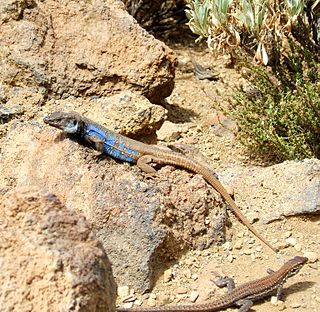
The genus Gallotia are the lacertids of the Canary Islands. This genus consists of a group that has been evolving there ever since the first islands emerged from the sea over 20 million years ago. The endemic species and subspecies of this group have a number of characteristics that make them quite special within their family (Lacertidae); their only close relatives are the sandrunner lizards (Psammodromus) of the western Mediterranean region. Gallotia are characteristic for eating significant quantities of plants, and several lineages are often presented as classic examples for insular gigantism. However, a find of an even larger Gallotia species from the early Miocene of mainland Europe casts doubt on this assumption. Instead the ancestor of all modern Gallotia species of the Canary islands was probably already very large but carnivorous.

Lacerta is a genus of lizards of the family Lacertidae.

The viviparous lizard, or common lizard, is a Eurasian lizard. It lives farther north than any other species of non-marine reptile, and is named for the fact that it is viviparous, meaning it gives birth to live young. Both "Zootoca" and "vivipara" mean "live birth", in (Latinized) Greek and Latin respectively. It was called Lacerta vivipara until the genus Lacerta was split into nine genera in 2007 by Edwin Nicholas Arnold Arribas & Carranza.
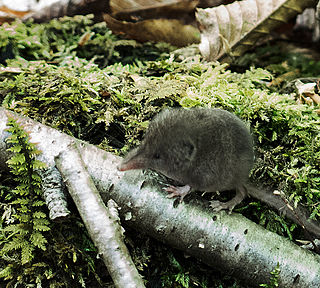
The North American least shrew is one of the smallest mammals, growing to be only up to 3 inches long. It has a long pointed snout and a tail never more than twice the length of its hind foot. The dense fur coat is either grayish-brown or reddish-brown with a white belly. Its fur becomes lighter in the summer and darker in the winter. Although similar in appearance to several species of rodents, all shrews are members of the order Eulipotyphla and should not be mistaken for a member of the order Rodentia. The North American least shrew's eyes are small and its ears are completely concealed within its short fur, giving it very poor eyesight and hearing.

Proceratosaurus is a genus of carnivorous theropod dinosaur from the Middle Jurassic (Bathonian) of England. It contains a single species. P. bradleyi, known from a mostly complete skull and lower jaws. Proceratosaurus was a small dinosaur, estimated to measure around 3 m (9.8 ft) in length. Its name refers to how it was originally thought to be an ancestor of Ceratosaurus, due to the partially preserved portion of the crest of Proceratosaurus superficially resembling the small crest of Ceratosaurus. Now, however, it is considered a coelurosaur, specifically a member of the family Proceratosauridae, and amongst the earliest known members of the clade Tyrannosauroidea.
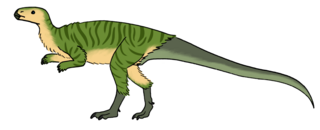
Changchunsaurus is an extinct genus of small herbivorous dinosaur from Early Cretaceous deposits of Gongzhuling, Jilin, China. It is the first named dinosaur genus from Jilin.

Ericiolacerta is an extinct genus of small therocephalian therapsids from the early Triassic of South Africa and Antarctica. Ericiolacerta, meaning "hedgehog lizard", was named by D.M.S. Watson in 1931. The species E. parva is known from the holotype specimen which consists of a nearly complete skeleton found in the Lystrosaurus Assemblage Zone within the Katberg Formation of the Beaufort Group in South Africa, and from a partial jaw found in the Lower Triassic Fremouw Formation in Antarctica. Ericiolacerta was around 20 centimetres (7.9 in) in length, with long limbs and relatively small teeth. It probably ate insects and other small invertebrates. The therocephalians – therapsids with mammal-like heads – were abundant in Permian times, but only a few made it into the Triassic. Ericiolacerta was one of those. It is possible that they gave rise to the cynodonts, the only therapsid group to survive into post-Triassic times. Cynodonts gave rise to mammals.

Secodontosaurus is an extinct genus of "pelycosaur" synapsids that lived from between about 285 to 272 million years ago during the Early Permian. Like the well known Dimetrodon, Secodontosaurus is a carnivorous member of the Eupelycosauria family Sphenacodontidae and has a similar tall dorsal sail. However, its skull is long, low, and narrow, with slender jaws that have teeth that are very similar in size and shape—unlike the shorter, deep skull of Dimetrodon, which has large, prominent canine-like teeth in front and smaller slicing teeth further back in its jaws. Its unusual long, narrow jaws suggest that Secodontosaurus may have been specialized for catching fish or for hunting prey that lived or hid in burrows or crevices. Although no complete skeletons are currently known, Secodontosaurus likely ranged from about 2 to 2.7 metres (7–9 ft) in length, weighing up to 110 kilograms (250 lb).
Fraas's lizard is a species of lizard in the family Lacertidae. The species is native to Western Asia.

The stone moroko, also known as the topmouth gudgeon, is a fish belonging to the Cyprinid family, native to Asia, but introduced and now considered an invasive species in Europe and North America. The fish's size is rarely above 8 cm and usually 2 to 7.5 cm long.

Eocyclotosaurus is an extinct genus of mastodonsauroid temnospondyl from the Middle Triassic (Anisian). The name Eocyclotosaurus means "dawn round-eared lizard". It is characterized as a capitosauroid with a long and slender snout, closed otic fenestra, and small orbits. It measured over one metre and had a 22 cm skull.

Plesiotylosaurus, meaning "near Tylosaurus", is an extinct genus of marine lizard belonging to the mosasaur family. It is classified as part of the Mosasaurinae subfamily, alongside genera like Mosasaurus and Prognathodon. The genus contains one species, Plesiotylosaurus crassidens, recovered from deposits of Middle Maastrichtian age in the Moreno Formation in California.
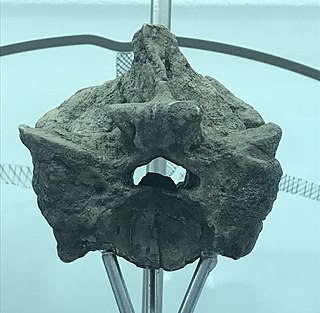
Titanoboa is an extinct genus of giant boid, the family that includes all boas and anacondas, snake that lived during the middle and late Paleocene. Titanoboa was first discovered in the early 2000s by the Smithsonian Tropical Research Institute who, along with students from the University of Florida, recovered 186 fossils of Titanoboa from La Guajira in northeastern Colombia. It was named and described in 2009 as Titanoboa cerrejonensis, the largest snake ever found. It was originally known only from thoracic vertebrae and ribs, but later expeditions collected parts of the skull and teeth. Titanoboa is in the subfamily Boinae, being most closely related to other extant boines from Madagascar and the Pacific.
Rotaurisaurus is an extinct genus of amphibian-grade tetrapod from the family Lapillopsidae. This genus is known only from an incomplete crushed skull and associated left jaw, together given the designation UTGD 87795. The generic name, Rotaurisaurus, is a combination of Latin words translating to "circle-eared lizard". This references the shape of its otic notches, which acquire a circular form due to being partially enclosed by the tabular bones at the back of the skull. The specific name, contundo, references the specimen's poor level of preservation, as it is derived from the Latin word for "squashed".

Mesenosaurus is an extinct genus of amniote. It belongs to the family Varanopidae. This genus includes two species: the type species Mesenosaurus romeri from the middle Permian Mezen River Basin of northern Russia, and Mesenosaurus efremovi from the early Permian (Artinskian) Richards Spur locality. M. romeri’s stratigraphic range is the middle to late Guadalupian while M. efremovi’s stratigraphic range is the Cisuralian.

Phrynocephalus persicus, commonly known as the Persian toad-headed agama, is a small diurnal desert lizard of the family Agamidae. It is the westernmost representative of the Central Asian genus of toad-headed agamas Phrynocephalus and is only known from deserts and semideserts of Iran and possibly Azerbaijan.
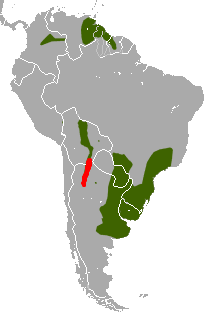
Massoia's lutrine opossum is a species of opossum native to South America.
Lacertulus is an extinct genus of lizard-like reptile, possibly a lepidosauromorph, from the Karoo Supergroup of South Africa. It contains a single species, Lacertulus bipes, which is based on a small articulated skeleton stored in the Transvaal Museum in Pretoria. The origin and locality of the specimen is unknown, though it is embedded in a greenish-gray siltstone similar to some sediments from the Late Permian Daptocephalus Assemblage Zone. The skeleton is mostly complete apart from the distal part of the tail, but erosion and improper preparation has damaged the skull and parts of the torso. Though originally described as a lepidosaur, poor preservation has lent doubt to this conclusion. Lacertulus is notable for its small size and proportionally small forelimbs relative to the large and well-ossified hindlimbs. The short humerus in particular suggests that it was capable of some degree of bipedal locomotion when escaping predators, by comparison to modern facultatively bipedal lizards such as Crotaphytus.


















